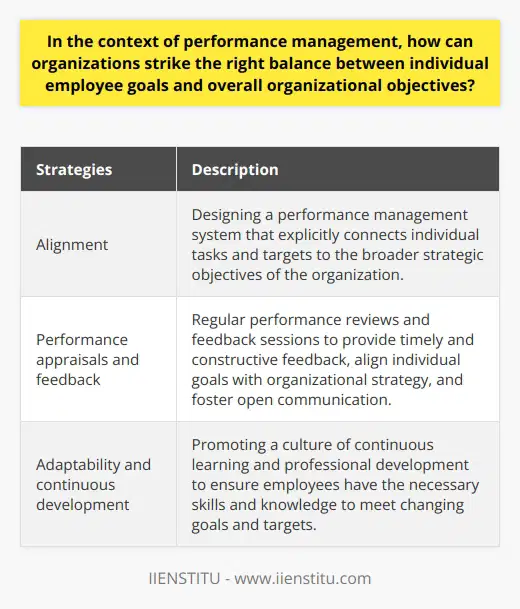
How Performance Management Affects the Individual
Building Development Plans
Benefits of Effective Performance Management
Why should you pay attention to performance management, particularly if you're an individual? Sure, it's an HR function that can help with team management, productivity, and efficiency, but what's in it for you? What are the benefits of performance management that relate to you?
When performance management is done right, it can hugely benefit the individual; it can help increase job satisfaction, streamline their work, and even build career development plans. Moreover, it helps boost individual growth and success, so it should not be solely managed at the team/organizational level.
Performance management is an ongoing process of setting performance expectations and objectives, tracking progress against those objectives, providing feedback, and offering guidance and support to individuals to help them progress. It's a cyclical process that allows the organization and its people to achieve their goals.
When individuals recognize the increasing role of performance management in their success and career development, they can tap into significant benefits. Here are the key benefits to consider when it comes to performance management:
How Performance Management Affects the Individual
Positive Effects on Job Satisfaction - Performance management can positively impact job satisfaction by providing employees with clear performance expectations. Knowing what's expected regarding tasks and results can help employees feel a sense of purpose and remain engaged in their work. In addition, positive feedback and recognition of exemplary performance reinforce job satisfaction and allow employees to challenge themselves.
Increased Productivity and Efficiency - Performance management can encourage employees to take ownership of their roles and to be self-driven and motivated. Employees can become more productive, efficient, and goal-oriented by identifying goals, setting objectives, and providing feedback and guidance.
Building Development Plans
When implemented effectively, performance management provides opportunities for employees to identify their strengths and weaknesses, understand how to improve their skills, and assess how their performance impacts the organization's success. Employees can build development plans through honest and constructive feedback that helps them grow and produce better outcomes.
Identifying Strengths and Weaknesses - Performance management can help employees identify their strengths to expand their knowledge and expertise in particular areas. On the flip side, it can also help them become aware of their weaknesses and assess how they can use those as a tool for development and growth.
Establishing Goals and Objectives - Performance management can help employees visualize their goals and objectives and set benchmarks for their performance. This can help employees stay focused and make progress toward their goals, which in turn can inspire them to stay engaged and motivated.
Benefits of Effective Performance Management
Improved Employee Retention - Performance management can help create an environment where employees feel respected and valued for their contributions. Establishing a culture of feedback and continuous learning can help employees stay engaged and, in turn, can boost employee retention rates.
Developing Talent - Performance management can help create a learning-focused culture encouraging employees to learn and develop their skills. This is especially important for organizations looking to recruit and retain talented employees. Performance management can help identify, nurture, and retain top talent and set the stage for long-term growth and success.
Conclusion: Performance management is vital in helping employees reach their goals and better manage their work. When done right, it can provide individuals with greater job satisfaction, help them become more productive and efficient, contribute to their growth and development, and even improve employee retention. All of these can greatly benefit an individual, so paying attention to performance management and ensuring it's working for you is essential.
Know the value of your performance and demand the reward that it deserves

Frequently Asked Questions
What are the benefits of Performance Management?
Performance management is an integral component of any successful business organization. It is a combination of processes and tools by which an organization can evaluate employees’ job performance and identify areas where improvement is necessary. As a result, implementing performance management tools can help organizations achieve their desired goals while maximizing employee productivity and satisfaction.
The adoption of performance management programs provides multiple benefits to organizations. First, performance management improves communication between management and employees by providing a structured and consistent platform for discussing and assessing workplace performance. This form of communication enhances employee engagement and job satisfaction by encouraging active listening. Additionally, performance management encourages goal setting and helps align individual goals with organizational objectives. This assists organizations in achieving their overall strategic vision.
Performance management also increases accountability within an organization as employees are measured and evaluated regularly. This facilitates the early identification of performance issues and allows managers to step in and provide guidance and assistance to employees struggling in their job roles. Moreover, performance management systems provide valuable information about individual employee performance that can be used to design training programs, adjust compensation and benefits, and recognize successful employees.
MPerformancemanagement enables organizations to optimize employee recruitment, hiring, and retention. Through the evaluation of job performance and employee behavior, organizations can more effectively identify and assess potential candidates for employment and identify opportunities for professional development and growth. This also reduces employee turnover as performance management is a feedback platform and rewards employees who demonstrate positive results.
In summary, there are numerous benefits to adopting a performance management system. Organizations can effectively identify and address performance issues, optimize talent recruitment, and increase employee engagement and satisfaction levels by establishing a structured platform for evaluation, communication, and goal setting. Additionally, performance management systems empower organizations to recognize and reward successful employees, thus motivating them to strive for more excellent performance. Therefore, performance management systems play an essential role in the success of organizations.

How does Performance Management help employees develop their skills?
Performance management is an essential tool for helping employees to develop their skills. A well-structured performance management process can enable employees to understand their current position and how they can grow through training and development. This can include setting goals and reviewing progress, helping identify suitable opportunities for professional development, and creating a growth plan.
One key aspect of performance management is goal setting. It helps to understand employees' expectations and how they can achieve their objectives. In addition, setting measurable and achievable goals encourages employees to evaluate and reflect on their performance and progress. This allows employees to identify areas needing additional training or development to improve their skills and enhance their performance.
Performance management can also help employees to identify gaps in their knowledge and skill sets. This is done through the use of feedback and reviews. Regular performance reviews can be invaluable in helping employees to identify areas for improvement. Through regular inspections, supervisors can provide feedback on an employee's performance and areas for development. This feedback can help employees identify relevant training or development programs to enhance their skills.
Performance management can also help employees to feel more confident in their abilities by providing a safe environment for them to discuss areas for improvement and receive constructive criticism. This can often identify weaknesses that might not be uncovered in a regular review. In addition, providing an opportunity for employee feedback helps to promote an open and collaborative working culture, which can lead to improved morale and overall job satisfaction.
In conclusion, performance management is essential for helping employees develop their skills. Through goal setting, regular reviews, and providing an opportunity for feedback, employees can identify areas for improvement and develop the skills needed to become better employees. Therefore, performance management benefits employees and the organization by creating a more productive and satisfied workforce.
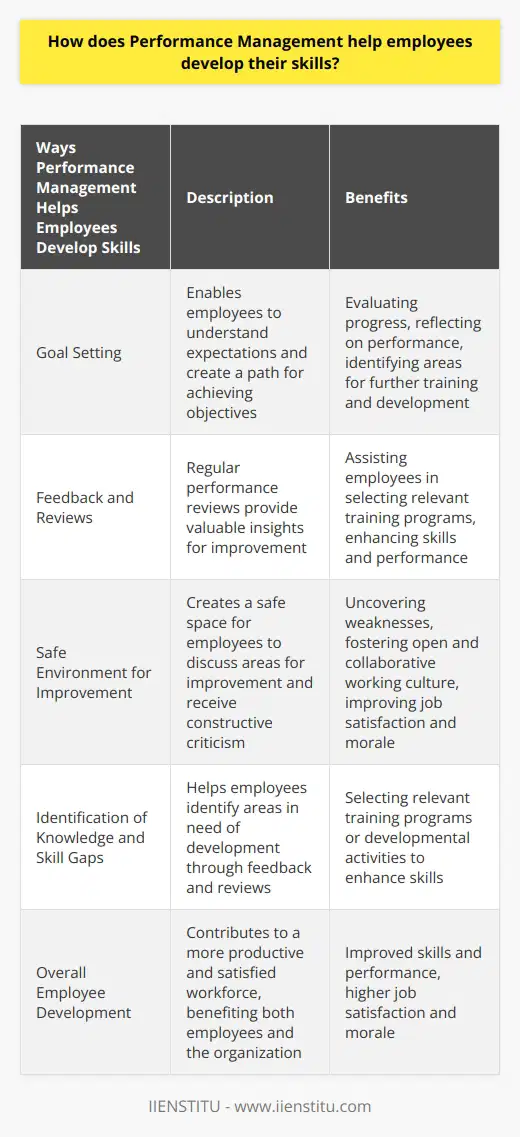
How does Performance Management ensure that employee performance is managed effectively?
Performance management is an essential strategy for businesses and organizations to help ensure employees perform to their full potential. An effective performance management system motivates employees to work to their highest capacity, develops their skills and knowledge, identifies performance deficiencies, and provides feedback and guidance on improving performance effectively.
Performance appraisals are essential for performance management as they help evaluate overall performance and identify improvement areas. Performance objectives should be set through the appraisal process, feedback should be given, and any areas of concern should be discussed. Goal setting should also be included as part of the appraisal process, as this effectively motivates employees and increases performance.
To ensure effective performance management, it is also essential to provide regular feedback and recognition to employees. Regular feedback shows employees their work is appreciated, improving motivation and productivity. It also allows supervisors to identify improvement areas and provide guidance and support to team members.
Performance management should also include ongoing training and development opportunities, job enlargement and enrichment activities, and positive reinforcement to cultivate interest in the job and take advantage of each employee’s strengths. Assigning appropriate tasks and roles, and providing tools and resources for employees to complete tasks effectively, should also be considered when managing employee performance.
Effective performance management ensures that employees perform to their highest potential. It helps motivate employees, encourages growth and development, and corrects performance deficiencies. Through effective performance management, businesses can benefit from increased employee satisfaction, improved performance and productivity, and overall organizational success.
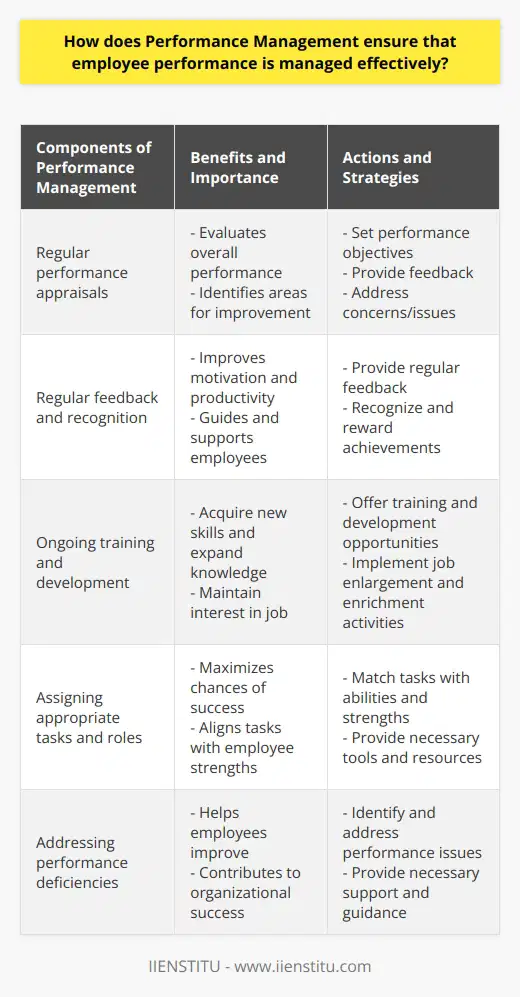
What are the 5 areas of performance management?
Performance Management Domains
**Goal Setting and Alignment**
In performance management, goal setting and alignment is crucial as it entails establishing performance objectives and ensuring their alignment with the organization's vision, strategy, and objectives. This process aims to improve employee engagement and foster a better understanding of organizational expectations, while promoting individual and organizational growth.
**Performance Monitoring and Measurement**
Monitoring and measuring performance is essential for evaluating the progress of employees and the overall organization. This area involves defining performance indicators, analyzing performance data, and providing feedback for areas of improvement. Regular monitoring of performance allows organizations to identify gaps, rectify inefficiencies, and ensure adherence to quality and productivity standards.
**Development Planning**
Development planning is a significant area that focuses on improving employee skills, knowledge, and competencies through targeted interventions, such as training courses, workshops, and self-directed learning initiatives. Development plans help organizations to retain and enhance human capital, making employees feel valued and empowered to perform at their best.
**Performance Appraisals**
Appraisals are a formal periodic assessment of employee performance, usually conducted through one-on-one review meetings between managers and employees. These evaluations facilitate candid discussions about employees' successes, areas of improvement, and future goals. Performance appraisals not only help employees recognize their potential but also contribute in decisions involving promotions, rewards, and recognition programs.
**Employee Feedback and Communication**
Effective communication and feedback are integral elements of performance management as they foster a culture of continuous improvement, building trust, and promoting mutual understanding between employees and the organization. Providing timely feedback helps address performance issues before they escalate and enables employees to adjust their performance in line with organizational expectations. Communications may take various forms, including informal conversations, written communications, and structured feedback sessions.
In conclusion, the five areas of performance management are essential to ensure sustained organizational success by facilitating goal alignment, monitoring and measuring performance, developing employees, conducting performance appraisals, and fostering open communication and feedback. Incorporating these domains within an organization's performance management system can lead to improved employee engagement, higher motivation levels, and overall better performance.
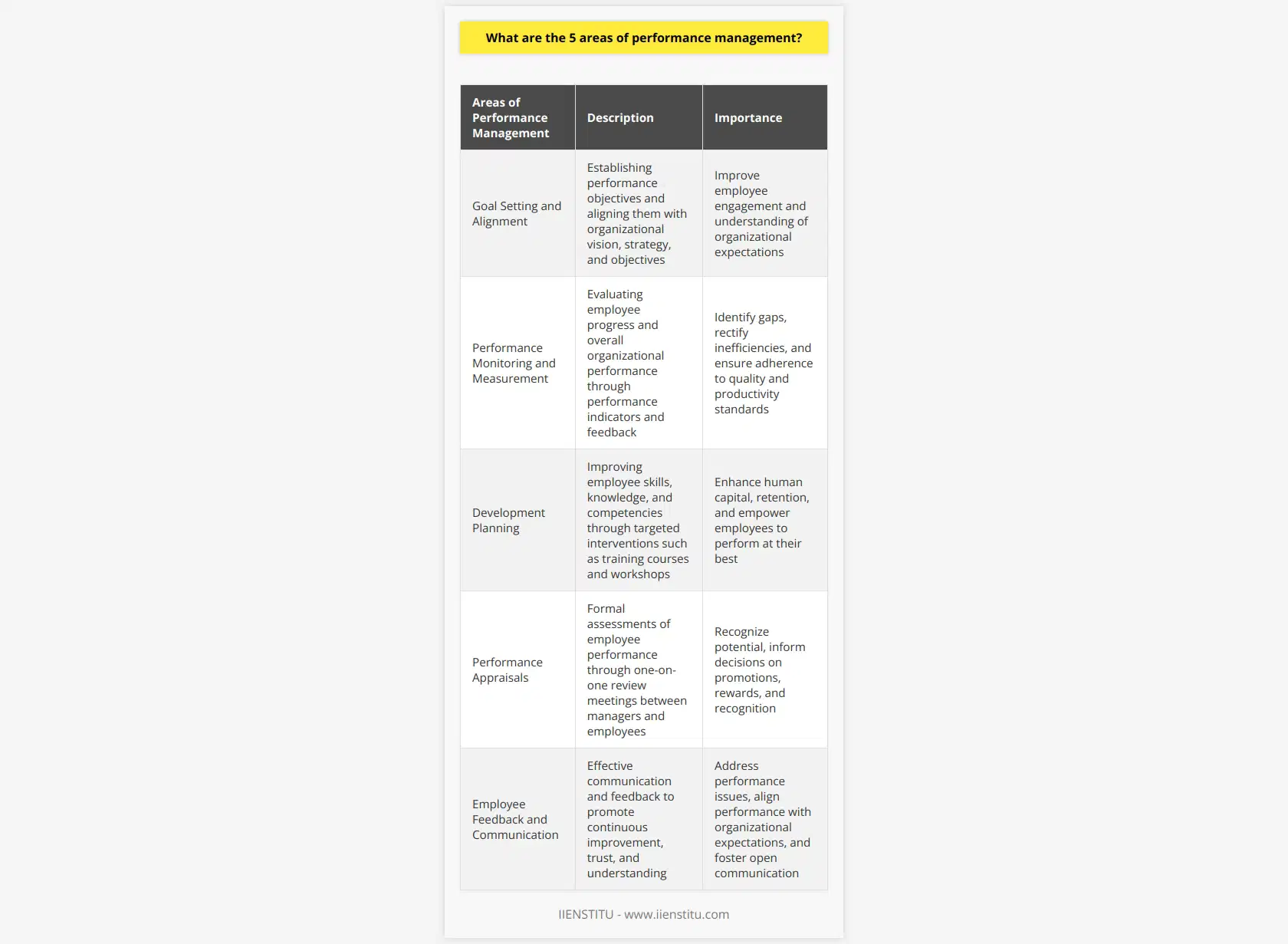
What are the 3 focus areas of performance management?
Focus Area One: Goal Setting and Alignment
The first focus area in performance management is goal setting and alignment. This process involves establishing clear, specific, and achievable objectives for individuals, teams, and the organization as a whole. These goals should be aligned with the company's mission, vision, and strategic plan to ensure that all employees are working towards a common purpose. Utilizing the SMART criteria (specific, measurable, achievable, relevant, and time-bound) can help ensure effective goal setting and alignment.
Focus Area Two: Performance Monitoring and Assessment
The second focus area of performance management is performance monitoring and assessment. This involves continuously evaluating employee performance and providing regular, constructive feedback to help employees understand their strengths and areas for improvement. Businesses can maintain performance data through various methods, such as key performance indicators (KPIs), individual or team targets, and regular progress reports. Performance monitoring should be an ongoing process, instead of merely an annual event, to foster constant improvement and adaptation.
Focus Area Three: Performance Improvement and Development
The third focus area of performance management is performance improvement and development. This aims at enhancing employee skills, knowledge, and abilities to continually raise their performance levels. This aspect of performance management can be achieved through different strategies, including training and development programs, coaching, mentorship, and providing employees with the necessary resources to fulfill their tasks. Organizations should also establish a culture of continuous learning, encouraging employees to seek new challenges and growth opportunities actively.
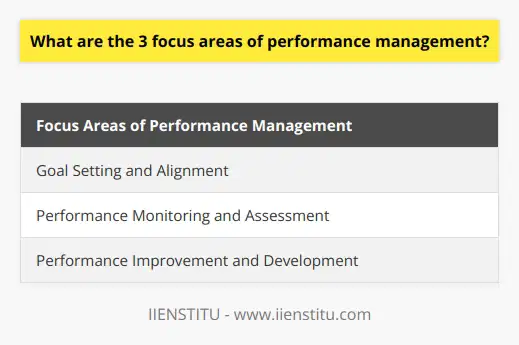
What are the 3 purposes of performance management?
Three Key Purposes
To begin with, performance management is essential for enhancing the overall productivity and effectiveness of an organization. It is a systematic process through which managers and employees align their goals, resources, and efforts to meet the desired outcomes. There are three key purposes of performance management, namely, strategic alignment, employee development, and performance measurement.
Strategic Alignment
First and foremost, performance management ensures strategic alignment, which refers to the process of connecting an organization's goals with the objectives of each employee. This alignment is crucial, as it enables employees to understand their role in driving the company's success. By clearly communicating expectations, managers can establish a performance culture that is focused on achieving the organization's mission and vision, thereby promoting collaboration and teamwork.
Employee Development
Secondly, performance management plays a pivotal role in fostering employee development. Continuous feedback, coaching, and support from supervisors empower employees to identify their strengths and weaknesses, set realistic goals, and create a roadmap to improve their knowledge and skills. By motivating individuals to engage in constant learning and growth, organizations can reap the benefits of skill enhancement, knowledge retention, and job satisfaction, which, in turn, contribute to increased overall performance and reduced employee turnover.
Performance Measurement
Lastly, performance management facilitates the measurement of individual and team performance through various evaluation techniques, such as goal-setting, competency assessment, and self-appraisal. These methods encourage open communication, constructive feedback, and recognition of achievements, thereby promoting a performance-driven culture. By systematically tracking and analyzing employees' progress, organizations can make informed decisions regarding compensation, promotion, and succession planning, driving greater efficiency and effectiveness in their operations.
In conclusion, the three purposes of performance management - strategic alignment, employee development, and performance measurement - are essential for fostering a high-performance culture in organizations. By aligning personal and organizational objectives, encouraging continuous growth, and ensuring accurate evaluations, performance management can significantly contribute to an organization's overall success.
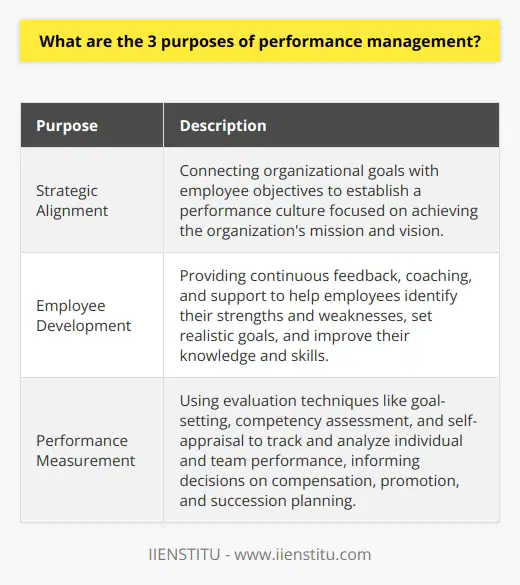
What does performance management mean to me?
Understanding Performance Management
To me, performance management is a systematic process by which organizations continuously assess, monitor, and enhance the performance of their employees to achieve strategic goals and maintain a high level of overall effectiveness. It encompasses a variety of management practices and methodologies, aiming at fostering a culture of continuous learning, improvement, and accountability in the workplace.
Role of Feedback and Communication
Central to the concept of performance management is the importance of regular feedback and communication between managers and employees. This enables both parties to discuss performance expectations, identify strengths and areas for development, and establish SMART (Specific, Measurable, Achievable, Relevant, and Time-bound) goals for the future. Thus, feedback and communication play a pivotal role in ensuring that employees understand their roles and responsibilities, and receive the necessary support to achieve their potential.
Monitoring and Evaluation
Performance management also involves regularly monitoring and evaluating employee performance to motivate and encourage progress, identify areas for improvement, and inform future development plans. This may include techniques such as performance appraisals, key performance indicator (KPI) tracking, and 360-degree feedback. By adopting a systematic approach to monitoring and evaluation, organizations can better identify trends, measure progress against goals, and make informed decisions regarding employees' career development and organizational growth.
Developing Employee Capabilities
Another key aspect of performance management is employee development, which includes learning and growth opportunities, skills enhancement, and career progression. This can involve a wide range of activities such as training programs, mentoring, coaching, and job rotations. Providing employees with opportunities to develop their skills and competencies not only boosts their performance but also contributes to higher job satisfaction, motivation, and retention rates in the organization.
Rewarding High Performance
Performance management also includes the recognition and rewarding of high-performing employees. This can be done through various mechanisms such as salary increases, promotions, bonuses, or other non-monetary rewards. By acknowledging and rewarding exceptional performance, organizations enhance employee motivation, engagement, and loyalty, ultimately driving them to achieve better results.
In conclusion, performance management is a comprehensive and dynamic process that enables organizations to build a high-performance culture by aligning individual and team performances with organizational goals. By focusing on feedback and communication, monitoring and evaluation, employee development, and rewards and recognition, performance management ensures that employees are continuously engaged, motivated, and committed to achieving excellence in their work.
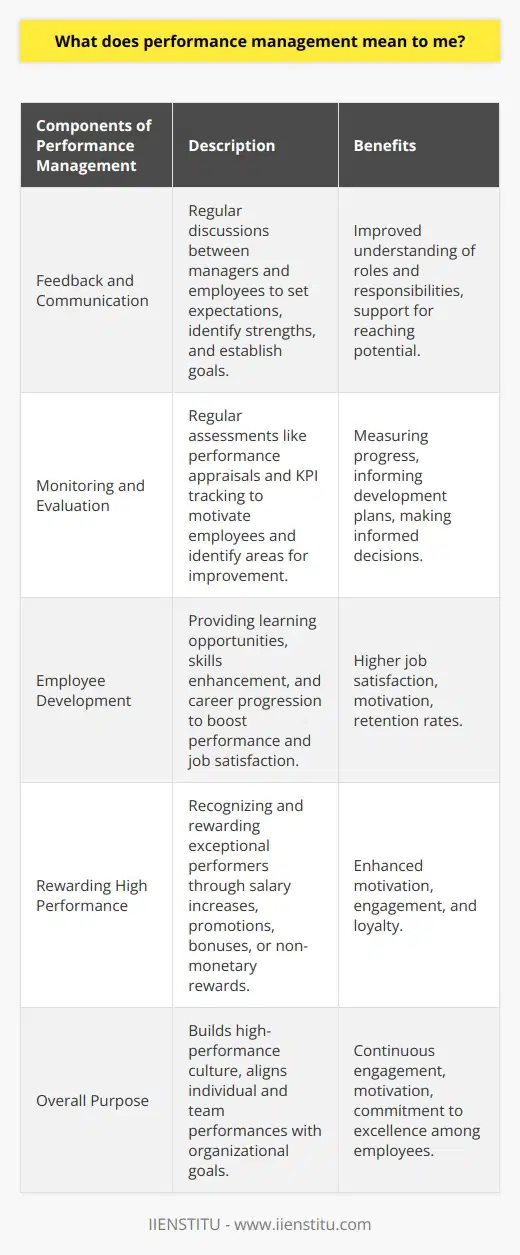
What are the key components of an effective performance management system?
Key Components of Performance Management
Goal Setting and Alignment
An effective performance management system must establish clear, specific, and measurable goals for employees, aligning them with the overall objectives of the organization. This ensures that individual efforts contribute to the broader organizational strategy and facilitates communication between managers and employees.
Performance Appraisal and Feedback
Regular performance appraisals allow for the objective evaluation of employees' work based on their goal achievement and other relevant criteria. Continuous feedback ensures that employees understand their strengths and areas for improvement, fostering professional development and growth. An effective performance management system should facilitate two-way communication, allowing employees to share their perspectives and insights.
Training and Development Opportunities
Providing ongoing training and development opportunities enable employees to build their skills and knowledge, enhancing their ability to meet performance expectations. An effective performance management system should identify areas where employees may need further support, tailoring development initiatives to individual and organizational needs.
Recognition and Rewards
Rewarding and recognizing employees for their achievements is another key component of an effective performance management system. In addition to promoting engagement and motivation, incentives can help reinforce positive behaviors and outcomes. These rewards can be both extrinsic, such as financial incentives or promotions, and intrinsic, such as praise and recognition from peers and leadership.
Continuous Improvement
An effective performance management system should be designed to continuously improve processes and practices, addressing any shortcomings or inefficiencies. By periodically reviewing and adjusting performance metrics, evaluation methods, and training initiatives, organizations can ensure that their performance management system remains relevant, fair, and effective.
In conclusion, there are several key components to an effective performance management system, including goal setting, performance appraisal, feedback, training, recognition, and continuous improvement. By incorporating these elements, organizations can create a performance management system that supports employee development, aligns individual efforts with organizational objectives, and drives overall success.
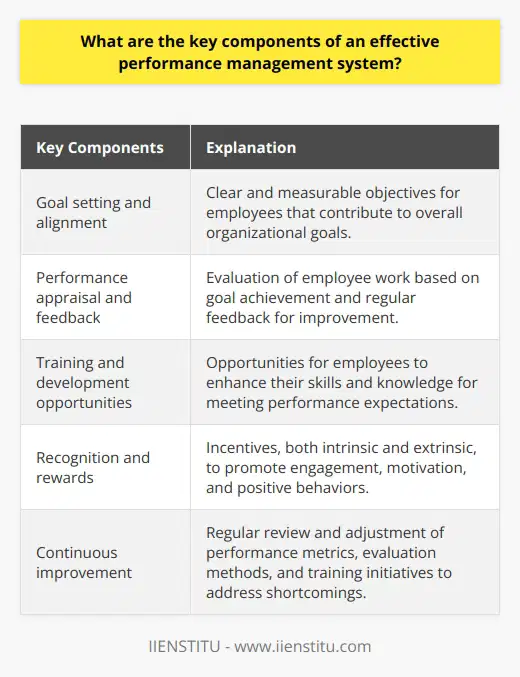
What do individuals and organizations hope to achieve through performance management?
Goal Setting and Alignment
Individuals and organizations alike aim to achieve several objectives through performance management strategies. Primarily, the process helps in setting clear performance expectations and aligning them with organizational goals. By establishing specific, measurable, attainable, relevant, and time-bound (SMART) objectives, employees can focus their efforts and contribute effectively to the organization's success.
Continuous Feedback and Improvement
Performance management also facilitates continuous feedback and improvement. Regular communication between managers and employees allows the identification of strengths, accomplishments, and areas needing improvement. Consequently, this information helps employees grow in their roles and improve their performance. In turn, this continuous loop of feedback can lead to increased employee satisfaction, engagement, and retention.
Identify Training and Development Needs
Another crucial aspect of performance management is identifying training and development needs for individuals, teams, and the entire organization. Evaluating performance helps to pinpoint skills gaps and areas where additional resources, training, or coaching may be necessary. Thus, performance management serves as a valuable tool for organizations to invest in their employees' growth and development.
Motivate and Engage Employees
Performance management can significantly impact employee motivation, engagement, and overall job satisfaction. By recognizing high performers and rewarding them accordingly, organizations can foster a motivating environment. Moreover, the transparency and objectivity provided through a robust performance management system ensure all employees receive fair evaluations, which further contributes to increased engagement levels.
Drive Organizational Success and Growth
In summary, performance management helps individuals and organizations achieve multiple objectives, ranging from goal setting and alignment to continuous improvement and engagement. By having a comprehensive performance management system in place, organizations can better equip their workforce, providing growth opportunities for employees. Ultimately, these efforts contribute to organizational success, enabling companies to remain competitive and achieve long-term sustainability.

What are the 4 areas of performance management?
**Performance Management Areas**
Performance management is a strategic process that focuses on enhancing employee productivity and organizational success. Four significant areas of performance management include goal setting, performance monitoring, feedback provision, and intervention implementation.
**Goal Setting**
The first area, goal setting, encompasses establishing clear and achievable objectives for employees to work towards. These goals align with the organization's overall strategy and help in steering employees' efforts in the right direction to achieve desired outcomes. Goal setting also encourages employee motivation and dedication, which contribute to improved overall performance.
**Performance Monitoring**
The second area, performance monitoring, involves evaluating employee progress towards achieving set goals. This evaluation may include regular reviews, data collection, and analysis to track employee performance and identify potential challenges. Accurate and timely performance monitoring allows organizations to recognize and acknowledge employees' hard work, thereby fostering a performance-driven culture.
**Feedback Provision**
The third area of performance management, feedback provision, aims to communicate the results of performance monitoring to employees, highlighting areas of accomplishment and improvement. Open and constructive feedback promotes employee development, enabling them to understand their strengths and weaknesses, as well as identifying the required support and resources to enhance their performance.
**Intervention Implementation**
Lastly, intervention implementation focuses on identifying and addressing performance gaps and challenges identified through monitoring and feedback. Organizations may employ various intervention strategies like training, coaching, and mentoring to help employees improve their skills and overcome obstacles. This not only assists in attaining organizational objectives but also fosters greater employee satisfaction and motivation.
In conclusion, performance management comprises four intertwined areas that work collectively to optimize employee performance and drive organizational success. By effectively implementing goal setting, performance monitoring, feedback provision, and intervention implementation, organizations can create a dynamic working environment where employees feel motivated, supported, and empowered to achieve their full potential.
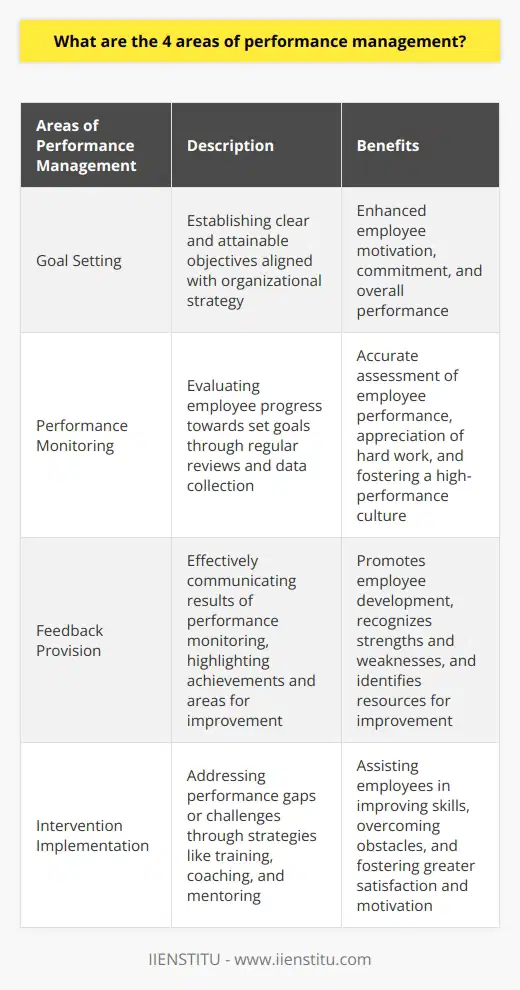
In the context of performance management, how can individuals and organizations create a culture of continuous improvement?
Fostering a Growth Mindset
To create a culture of continuous improvement in performance management, individuals and organizations must develop a growth mindset. This entails cultivating a belief in one's ability to learn, develop new skills, and consistently enhance performance. This mindset can be fostered through self-reflection, embracing challenges, and developing resilience to setbacks.
Effective Feedback Mechanisms
Crucial to continuous improvement is implementing effective feedback mechanisms. This involves creating channels for timely, constructive feedback from managers, peers, and even clients. Importantly, individuals should be encouraged to not only receive but also provide feedback to others, promoting a reciprocal culture where all members take responsibility for their growth and development.
Setting Clear Expectations and Goals
Establishing clear expectations and goals for performance can guide individuals and organizations towards continuous improvement. These expectations should be aligned with the organization's overall mission and should be revisited and updated regularly. When setting these goals, it is essential to involve employees in the process and ensure that they have a clear understanding of how their efforts contribute to broader organizational objectives.
Pursuing Skills Development
Investing in continuous learning and development programs can foster continuous improvement. Organizations should provide access to training opportunities, mentorship programs, and resources that enhance current skill sets and facilitate the development of new ones. This not only benefits individuals by enabling professional growth but also contributes to the ongoing success of the organization as a whole.
Measuring and Rewarding Progress
Tracking and measuring progress is an integral component of fostering a culture of continuous improvement. Organizations should implement key performance indicators (KPIs) and regular assessment tools to evaluate individual and collective performance. Celebrating and rewarding success – whether through monetary incentives, recognition, or career advancement opportunities – can further motivate employees to strive towards excellence.
In summary, creating a culture of continuous improvement in performance management requires fostering a growth mindset, implementing effective feedback mechanisms, setting clear expectations and goals, developing skills, and measuring and rewarding progress. By nurturing an environment in which individuals can continuously learn, develop, and grow, organizations can drive performance improvements and long-term success.
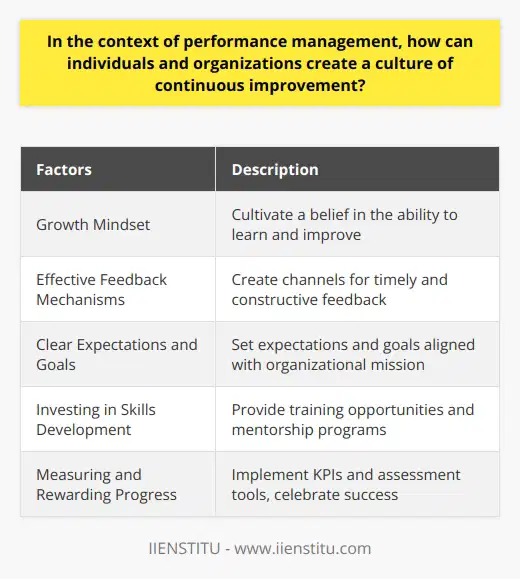
Which key performance indicators (KPIs) are most commonly used in performance management to accurately measure progress and success?
Key Performance Indicators in Performance Management
Defining and Measuring KPIs
In performance management, Key Performance Indicators (KPIs) serve as valuable tools to gauge progress and success. KPIs, as quantifiable measures, provide insights into the effectiveness of organizations, departments, teams, or individuals. To ensure accurate assessment, it is crucial to identify the most commonly used KPIs in performance management.
Financial Metrics
In essence, financial metrics are frequently employed to determine the fiscal health of a business and measure profitability. Indicators like revenue growth rate, net profit margin, and return on investment (ROI) highlight a company's financial performance. By closely monitoring these metrics, organizations can take informed decisions and implement data-driven strategies for growth.
Operational Metrics
Operational KPIs are crucial in assessing an organization's efficiency, productivity, and overall performance. Common examples include employee productivity, number of customers served, and product quality metrics. These indicators are valuable for monitoring progress and identifying areas in need of improvement, helping organizations optimize processes and resources.
Project Metrics
For organizations managing multiple projects and teams, project-centric KPIs are essential in tracking progress and success. Time-based metrics, like project completion percentage, time to market, and budget variance, provide insights into the project's performance over time. By analyzing these indicators, managers can ensure timely delivery and optimal allocation of resources.
Sales and Marketing Metrics
Effective sales and marketing strategies are vital in driving revenue growth and overall business success. Some of the most commonly used KPIs in this area include conversion rates, customer acquisition cost, and customer lifetime value. By examining these metrics, organizations can fine-tune their marketing initiatives and tailor sales approaches to attract and retain customers more effectively.
Employee-Related Metrics
Lastly, employee-based KPIs offer insights into employee performance, engagement, and satisfaction. Metrics like employee turnover rate, training effectiveness, and job satisfaction help organizations understand their workforce's strengths and weaknesses. By addressing these issues, companies can foster a positive work environment while enhancing productivity.
In conclusion, a diverse range of KPIs is essential for organizations in measuring their progress and success accurately. By employing these performance indicators, businesses can better evaluate their financial health, efficiency, project management, sales and marketing strategies, and employee satisfaction, allowing for the optimization of resources and continuous improvement of overall performance.

What is the role of performance management in promoting employee growth and development?
Role of Performance Management
Performance management plays a crucial role in promoting employee growth and development by setting clear expectations, evaluating performance, and providing feedback to employees. This process helps employees understand their strengths and weaknesses, and guides them to develop skills and knowledge necessary for their professional growth.
Setting Clear Expectations
The first step in performance management is setting clear expectations for employees, which involves defining performance objectives, establishing performance standards, and aligning individual employee goals with the organization's strategic objectives. This clarity helps employees understand their role and responsibilities, and sets the foundation for continuous learning and development.
Regular Evaluation and Feedback
Next, performance management involves regular evaluation of employee performance against the set expectations, which helps identify gaps in employee skills and knowledge. By assessing their performance, employees are given the chance to understand areas where they excel, as well as those that require improvement. Moreover, continuous feedback from supervisors or managers further promotes skill development and improvement of work performance.
Expanding Skills and Knowledge
Performance management systems facilitate employee growth and development by offering relevant learning opportunities such as training courses, workshops, and seminars based on employees' identified needs. This targeted skill-building and learning approach enhances the workforce's competence, ultimately leading to higher productivity and better overall organizational output.
Opportunities for Career Advancement
By focusing on employee development, performance management also encourages employees to seek opportunities for career advancement and growth within the organization. This includes promotions, lateral moves, or transitions to new areas of the business, in line with their professional aspirations. As employees become more experienced and knowledgeable, they can assume higher-level positions with greater responsibilities, leading to the steady growth of their careers.
In conclusion, performance management plays a vital role in employee growth and development by setting clear expectations, providing regular evaluation and feedback, expanding employees' skills and knowledge, and offering opportunities for career advancement. Implementing effective performance management systems ultimately leads to a more skilled workforce, higher productivity, and overall organizational success.
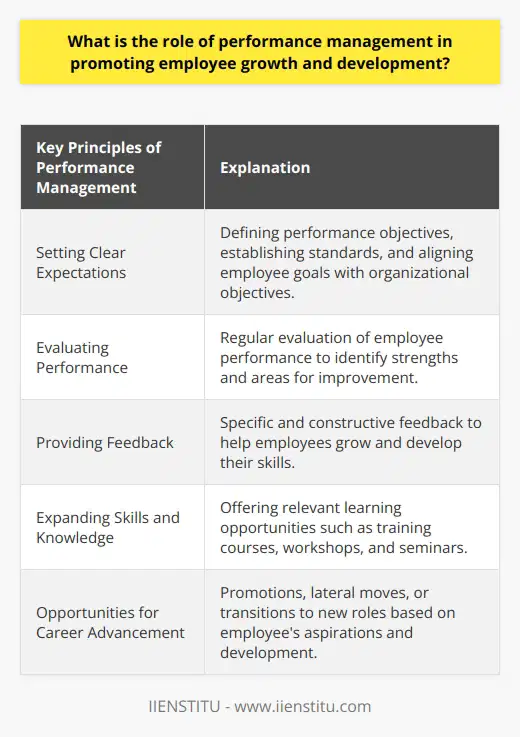
How does performance management contribute to organizational success and competitive advantage?
Performance Management and Organizational Success
Performance management is crucial in driving organizational success and competitive advantage, as it involves setting clear goals, monitoring progress, and providing constructive feedback. Managing employee performance effectively allows organizations to utilize their human capital to the fullest, optimally delivering on their objectives.
Goal Alignment and Performance
Aligning individual, team, and organizational goals is fundamental to achieving overall success. This alignment connects employees with the organization's mission and ensures that their efforts contribute towards common objectives. Performance management facilitates this alignment by establishing expectations and identifying areas for improvement.
Employee Engagement and Retention
Effective performance management fosters a positive work environment, promoting employee engagement and retention. Engaged employees are more likely to stay with the organization and contribute to its competitive advantage. Continuously assessing and addressing employee performance ensures that their potential is recognized and allows for career advancement opportunities.
Productivity and Efficiency
Performance management plays a pivotal role in improving productivity and efficiency within an organization. By setting measurable, attainable targets, employees can better understand their roles and contribute effectively. Regular feedback and performance reviews help identify areas for improvement and adopt best practices, contributing to overall organizational efficiency.
Quality and Customer Satisfaction
Managing performance also has a direct impact on product or service quality, which is critical to customer satisfaction. Ensuring that employees adhere to established standards and processes is essential for delivering consistent, high-quality outputs. Performance management helps organizations monitor and adjust employee behaviors to meet and exceed customer expectations.
Continuous Improvement and Innovation
Organizations that strive for continuous improvement and innovation can benefit significantly from performance management. Regular performance evaluations create opportunities to identify areas of potential growth and implement innovative solutions. By encouraging open communication and creating a feedback-driven culture, organizations can drive innovation and stay ahead of their competitors.
In conclusion, effective performance management contributes substantially to an organization's success and competitive advantage. By aligning goals, engaging employees, driving productivity and efficiency, ensuring quality and customer satisfaction, and fostering continuous improvement and innovation, performance management plays a vital role in an organization's growth and sustainability.
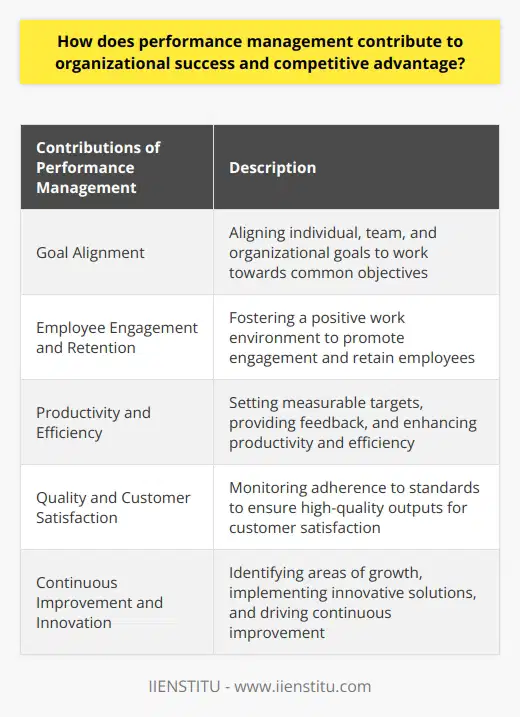
What are the best practices for implementing a successful performance management system within an organization?
Setting Clear Objectives and Goals
A successful performance management system begins with establishing clear objectives and goals. Managers should work with employees to set specific, achievable, and measurable objectives that align with the organization's strategic plans. This ensures that both parties understand the expectations and are working towards the same outcome.
Regular Feedback and Communication
Effective performance management systems require regular feedback and open communication between employees and managers. This can be achieved through regular check-ins, performance reviews, and employee evaluations. Providing constructive feedback and discussing employee progress enables both parties to understand where improvements are needed and where employees are excelling.
Employee Development Programs
Organizations should invest in employee development programs to provide continuous learning and skill-building opportunities for employees. These training sessions can be tailored to the needs of individual employees, fostering growth and increasing job satisfaction. By offering targeted development opportunities, organizations can enhance the performance of their employees and contribute to improved overall results.
Establishing Performance Metrics
Implementing performance metrics is essential to evaluate employee performance objectively. These metrics should be based on the specific goals and objectives set for each employee and tied to the organization's overall performance goals. Using data-driven metrics can help to identify areas that need improvement and encourage employees to focus on achieving measurable results.
Rewarding Employee Performance
A successful performance management system should include a reward system that recognizes and rewards employees for their achievements. This can take the form of monetary incentives, promotions, or recognition programs. By incentivizing performance, employees are more likely to remain engaged and motivated to achieve their goals.
Periodic Reviews and Adjustments
Lastly, a robust performance management system should include regular reviews and adjustments to ensure it remains effective and relevant. Organizations should continuously evaluate and improve their performance management systems, incorporating feedback from employees and making any necessary adjustments to adapt to changing business needs. This will ensure a long-lasting and successful performance management strategy within the organization.
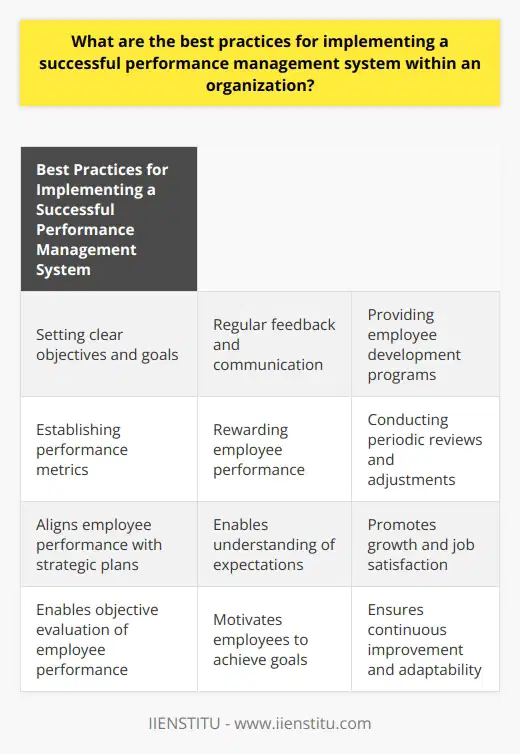
What is performance management in your own words?
Understanding Performance Management
Performance management designates an organized approach to improving individual and team productivity in an organization. It bridges the gap between organizational goals and individual performance.
Focus on Objective Setting
At the core of performance management lies objective setting. It involves setting clear expectations and goals for employees. This motivates them to perform optimally, ensuring they understand their roles effectively.
Regular Feedback and Assessment
Another crucial aspect is regular feedback and assessment. This involves continual monitoring of employee performance. It allows for constructive feedback, recognition of efforts, identification of training needs, and resolution of performance issues.
Integration of Developmental Activities
Performance management also integrates developmental activities. It includes upskilling and training programs targeted at enhancing employees' professional skills. It aids in addressing potential areas of improvements by keeping the workforce equipped and updated.
Employee Recognition and Reward System
Performance management also cultivates a culture of recognition and rewards. Here, the system fairly reimburses and appreciates good performance. This brings about job satisfaction, motivation and further enhances productivity amongst employees.
Alignment of Workforce and Business Goals
Implementation of performance management aligns the workforce with strategic business goals. It develops a shared vision amongst the workforce. This alignment ensures all individual efforts gravitate towards achieving organizational objectives.
Thus, performance management is a comprehensive, continuous process. It not only uplifts individual and team performance but also aligns these with organizational goals. Ultimately, it leads to enhanced productivity, workforce satisfaction and overall organizational growth.
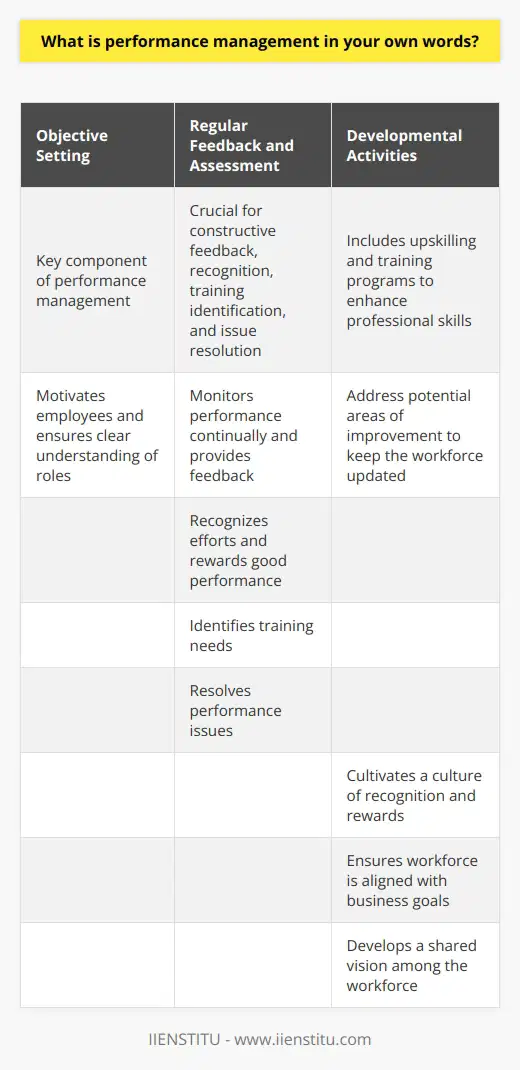
What are the key principles guiding the design and implementation of an effective performance management system?
Defining Parameters
A robust performance management system (PMS) must be clear and specific. It should define performance expectations and assess employees' skills and contributions accurately.
Measurement Criteria
The PMS should establish relevant measurement criteria. This ensures consistency and fairness in evaluating individual performance. Metrics may include specific tasks, behavioural attributes, or outcomes.
Feedback and Development
Feedback is a crucial element of a PMS. Regular feedback aids employees in identifying their strengths and improvement areas. Additionally, the PMS should incorporate a development plan to improve identified skill gaps.
Alignment with Organizational Goals
The PMS should align individual performance goals with those of the organization. This synchronization propels employees to work towards the collective mission, resulting in optimal organizational productivity.
Use of Technology
Utilizing appropriate technology can increase the effectiveness of a PMS. Tools like software applications can streamline the monitoring, tracking and reporting processes. Thus, technology lends efficiency to the system.
Employee Participation
A successful PMS promotes employee involvement, fostering motivation and commitment. This involvement could involve them setting their performance goals and assessing their performance along with their managers.
Transparency and Consistency
Finally, transparency and consistency form the backbone of an effective PMS. They uphold fairness, reduce bias and aid in building employees’ trust in the system. Clear communication on performance expectations and consistent application of policies can ensure this.
In conclusion, appropriate parameters, measurements, feedback, alignment to goals, use of technology, employee involvement and transparency formulate an effective performance management system.
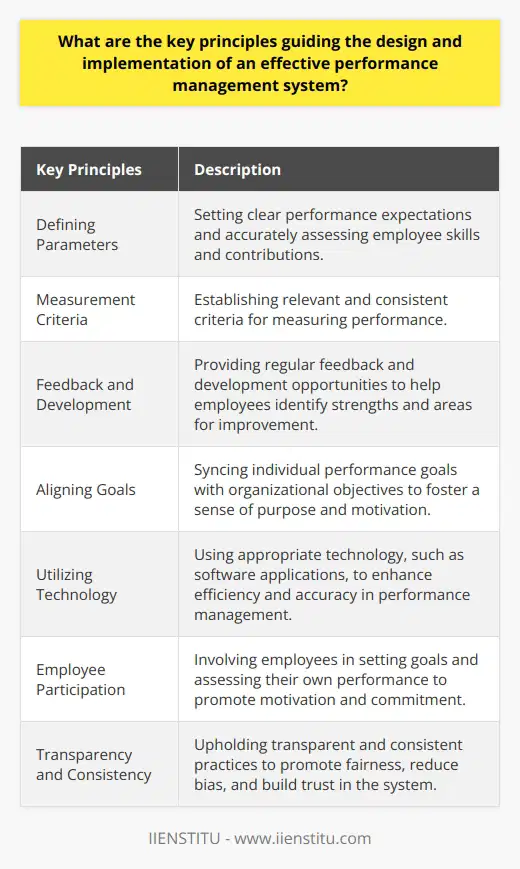
In the context of performance management, how can organizations strike the right balance between individual employee goals and overall organizational objectives?
Understanding Individual vs Organizational Objectives
Striking the right balance in performance management involves keen attention to both individual employee goals and overarching organizational objectives. Organizations can achieve this balance by developing a performance management system that, while focusing on individual performance, also ensures alignment with the larger organizational goals.
Alignment of Goals
Consistency between individual and organizational goals is crucial for effective performance management. This requires a system where individual tasks and targets sync directly with the strategic objectives of the organization. Such a system fosters employees' understanding of their contribution to the larger organizational success, boosting their engagement and productivity.
Performance Appraisals and Feedback
Regular performance appraisals and feedback play a key role in maintaining this balance. Managers should deliver timely, constructive feedback, recognizing individual success and addressing areas for improvement. Regular reviews can help align employee goals with the organizational strategy, ensuring that workers remain focused and motivated.
Adapting to Change and Continuous Development
Finally, continuous development and adapting to change are essential. Performance management itself is a dynamic process, requiring adjustments in response to evolving organizational objectives and individual employee goals. By promoting continuous learning and professional development, organizations can ensure their employees stay equipped with the skills and knowledge necessary to meet changing goals and targets.
In conclusion, achieving the perfect balance between individual and organizational goals demands a comprehensive, adaptable, and transparent performance management system. This system should prioritize goal alignment, regular feedback, and continuous development, fostering a productive and motivated workforce that drives organizational success.
